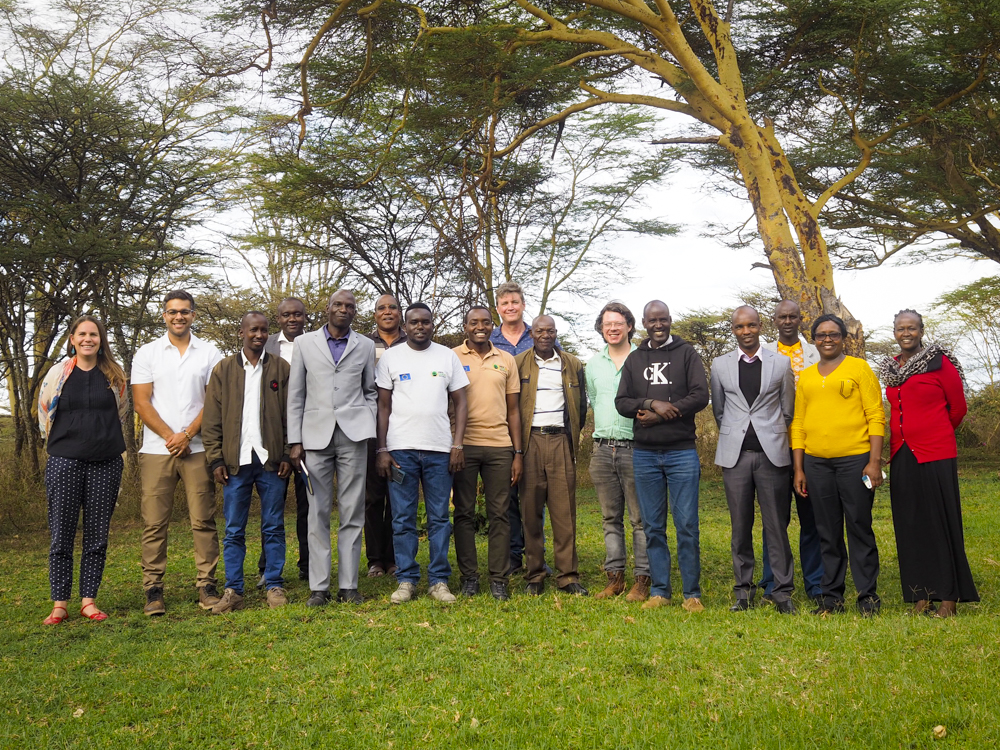






CLOCKWISE FROM TOP LEFT: E4Impact’s Chebet Cheruiyot, centre, with entrepreneurs Maiamu Kamasial and Nasha Bagiriani. | RangER’s vision. | Tree seedling recipients. | Net-Mapping exercise with project leads. | Kim Geheb, LFF Central Component coordinator, Net-Mapping with local community women. | NRT’s Aloise Nitira, ICRAF’s Eric Wanjira and LFF’s Kim Geheb inspect the new Nasuulu farm pond. | Virginia Wahome presents an overview of the work of the Amaya Triangle Initiative.
We couldn’t have asked for a warmer – or more accommodating – welcome than the one we received in April in magical Kenya, when the RangER (Kenya Rangelands Ecosystem Services pRoductivity) Programme hosted members of the Central Component on our first learning mission.
Since four of the five mission team members are based in Nairobi and ICRAF is one of the project partners, RangER was an obvious choice for our first trip, aimed at informing and adapting our Learning Strategy and Protocol. Aloise Naitira, RangER’s programme lead, accommodated our needs admirably with a three-day agenda that included a combination of bi-lateral interviews with project teams, a Net-Mapping exercise to discuss stakeholder engagement and power dynamics, presentations and discussion on the project’s theory of change, and field visits to a newly-built surface run-off pond and the hand-over of trees to one of the communities.
About RangER
We quickly discovered that ameliorating communal conflict in the area is one of RangER’s major goals, which identifies a clear relationship between livelihoods, environmental degradation and drought (or, at least, reduced access to natural resources), and conflict in the Amaya Triangle, a mosaic of savanna grasslands, shrublands and woodlands to the north of Mount Kenya.
Traditional pastoralist communities living in the region are among the most marginalized and poorly served groups in Kenya, living within a highly degraded landscape and facing high levels of poverty and threats from conflict. Key wildlife and pastoralist grazing corridors connect the four participating counties – Baringo, Laikipia, Samburu and Isiolo – at a landscape level, with livestock and wildlife transiting to the Aberdare mountain range to the southwest and Mount Kenya to the east, especially during drought years.
The area hosts private and community conservancies which support both livestock production and wildlife conservation. Increasing changes in land use away from pastoralist rangeland to crop production and settlements have resulted in clusters of problems around insecurity, resource conflicts, poverty, food insecurity, social exclusion, and severe degradation of natural resources. Frequent droughts and climate change coupled with human and livestock population growth have exacerbated this situation.





CLOCKWISE FROM TOP LEFT: Typical pastoralist scenery: herder and cattle on the move. | Honey entrepreneur Samuel Kipyo. | Isiolo market chairman Abdi Hallake. | Drought conditions around the Nasuulu farm pond. | First greenery after the rains at Lewa Wildlife Conservancy, home to NRT’s headquarters.
We learned…
One of the core activity areas of the Central Component is systematizing the knowledge and lessons generated from the implementation of the 22 ILM projects in our programme. Our learning visits are intended to yield answers to 32 targeted questions on ILM readiness and implementation.
RangER’s lead organisation, the Northern Rangelands Trust (NRT), has long experience with conservation through communities, which will have considerable relevance to other conservation-oriented projects in the LFF programme. Here’s a sample of our findings about the project they lead, centred around the six ‘characteristics’ of ILM we have identified.

Stakeholder identification
The project’s Theory of Change (ToC) was presented by Dr Clifford Obiero from Jomo Kenyatta University of Agriculture and Technology, a key partner in the project. The ToC is dependent on the Northern Rangelands Trust’s (NRT) ‘community conservancy model’ – which “has been piloted, tested, and proven to achieve multiple objectives working at the nexus of livelihoods, biodiversity conservation and peace/security.”
NRT defines ‘community conservancy as a “community-owned and community-run institution which aims to improve biodiversity conservation, land management and the livelihoods of its constituents over a defined area of land traditional owned, or used, by that constituent community.”
NRT believes that the long-term success of conservation on community land depends on building strong, well governed community-owned institutions that ensure rights and responsibilities of conservation by local land-owners and equitable benefits to communities from conservation. Community Conservancies develop programmes for peace, livelihoods, conservation and business development; they provide a formal structure for partner engagement and an organized platform and voice for people to manage their common resources. Community Conservancies recognize the coexistence of people, their livelihoods and wildlife and the integration of all these in the management of the land. They do not create ‘hard’ boundaries which separate people from wildlife nor do they exclude other people from using the land.”

Multi-stakeholder fora (MSF)
MSF appear to be central to RangER’s systems and approach.
NRT/RangER staff would seem to be very capable facilitators, and the learning mission provided much to suggest that NRT has significant in-house negotiation capacity and convening power.

Common vision
The outcome described in the project’s logical framework is:
Improved sustainable rangelands ecosystem services productivity through climate smart natural resource management and natural resource-based livelihoods, effective governance, peace and security for both wildlife and people.
The project aims to achieve these via five results:
- Effective governance, wildlife, and human security: Amaya Counties are supported to deepen and build effective governance for adoption of climate smart livelihoods, peace and security.
- Co-production of knowledge to guide and inform project interventions: communities are assisted to map degraded hotspots and identify restoration options, undertake land use planning and adopt climate-smart livelihoods.
- Deepening and expanding the community conservancy model: communities are assisted to establish/strengthen existing cross-border and multi-ethnic conservancies and adopt climate resilient and ecologically sustainable feed livelihood systems.
- Re-designing landscape and promoting feed-and food-security through tree-and natural resource-based livelihood systems: communities will be introduced to different agroforestry and afforestation/reforestation options for feed-and food-security’.
- Support to integrated climate resilient and ecologically sustainable feed-and food-security and natural resource-based livelihood systems: support to sustainable county livelihood initiatives.

Institutionalisation
NRT – and RangER with it – is well institutionalised. The NRT is well resourced, attracts high capacity, and is supported by relatively sophisticated monitoring and decision-support systems. The NRT also enjoys the explicit support of the central government.
Institutionalisation also occurs at lower levels underneath the NRT, in which county government and communities are integrated into the NRT’s programme systems, implementing on behalf of the NRT. It is possible to argue that the NRT has the popularity it does in northern Kenya because many of its objective’s dovetail with those of the counties.

Iterative and adaptive management
The NRT’s project experience suggests that it has well-established systems and processes to enable this.

Technical solutions and tools
The project’s knowledge of its biophysical and ecosystem conditions is high. Its in-house and project-based systems for monitoring these trends are well established.
The project includes climate-change-related dimensions, inputs, activities and/or outcomes. The carbon credits raised via grassland seems particularly innovative.
Thanks

Thanks to this dynamic, hardworking, experienced and committed team, including leads of the project steering committee and county leaders, for sharing your expertise and insights so openly:
Northern Rangelands Trust: Aloise Naitira, Daniel Njihia , Abdikadir Bagajo and Elijah Waishanguru
Laikipia County: John Orata, George Ndungu, Virginia Wahome and Boniface Thumi
Samburu County: Daniel Lesaigor and Tony Leleruk
Community Safety Initiative: Lekamparish John, Julius Loishopoko, Robin Letunta and Milcah Lenolkurum
E4Impact Foundation: Judy Chebet, Nasha Kitonga and Nolotuesha Nkamasiai
Jomo Kenyatta University of Agriculture and Technology (JKUAT): Robai Liambila and Dr. Clifford Obiero



